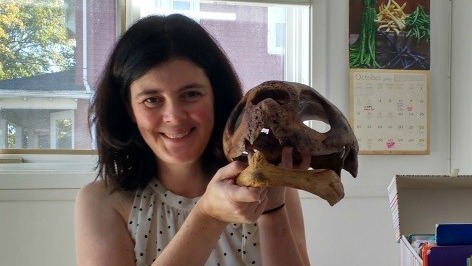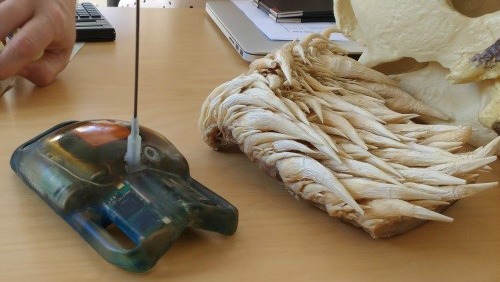Conservation
Volunteer network watches over endangered sea turtles
The Canadian Sea Turtle Network negotiates with fishermen and collect balloons to save leatherback turtles

caption
Executive director of the Candian Sea Turtle Network, Kathleen Martin, holds a leatherback sea turtle skull
caption
Executive director of the Candian Sea Turtle Network, Kathleen Martin, holds a leatherback sea turtle skull.Massive, ancient leatherback turtles swim in Nova Scotian waters but are rarely seen by the human eye.
Now, the Canadian Sea Turtle Network is hard at work raising awareness and helping to protect these prehistoric beasts.
“They’re huge, hungry, swimming dinosaurs,” says volunteer Scott MacPherson.
“What’s not to like?”
Executive director Kathleen Martin says there is a lot of work to be done to understand the 150-million-year-old species. Where other countries have been studying them since the 1960s, Canada didn’t begin its research until 1998.
Leatherback turtles are especially difficult to study, because they cannot survive in captivity.
“They always die. They are very prone to fungal infections, and they need a lot of space,” says Martin.
Leatherback turtles have the widest migration range of any reptile, swimming up to 20,000 kilometres a year. Despite this mobility, they’re unable to travel backwards.
“They make enormous migrations – and they don’t know how to reverse,” Martin says.
“This is an animal that has never been designed to be in a place with a corner or a door. The idea of boundaries doesn’t exist in their mind.”
Volunteer co-ordinator Kayla Hamelin works year-round with students and other helpers She and her group help create new research by locating turtles washed up on Nova Scotian shores.
“This is a rare opportunity to check out their physiology and anatomy,” she says.

caption
A transmitter alongside preserved spines from the inside of a turtle shell.The network operates out of a west end Halifax location and has a 24-hour line anyone can call toll-free to report turtle sightings. The number is 1-888-729-4667.
At their summer location on the Halifax harbour, Hamelin and volunteers conduct educational programs for anyone passing by. These free programs are targeted towards multiple age groups, from pre-school to adults. The goal is to raise awareness and knowledge about the endangered species.
The current status of these large reptiles in the Atlantic region is “vulnerable”. Leatherbacks qualify for protection under the federal Species at Risk Act. Other species, like the smaller loggerhead, do not.
Martin says that decisions of protection are not determined by vulnerability alone.
“They decided not to list tuna just this summer, because people like to catch it. They decided it was more important that we get money from it, so they didn’t list it, despite the fact that it is scientifically endangered species,” says Martin.
In Canadian waters, the biggest threats to sea turtles are fishing boats and gear.
Martin says they work closely with Atlantic fishermen to negotiate safer fishing practices. Individual turtles are tagged with electronic devices that monitor everything from location to dive frequency and depth.
Outside of Canada, there are many more threats. Illegal trade and poaching is a problem along the Caribbean coast. Shipments of narcotics often overlap with ideal nesting grounds. In some cases, turtles will be killed for their eggs.
“They’ll even open up the female and take whatever eggs are developing inside of her body,” says Martin.
Traveling and working in these regions can even be dangerous.
Martin points to the case of murdered conservationist Jairo Mora Sandoval as proof. He was killed in Costa Rica trying to protect leatherback nests from poachers.
Still, Martin says witnessing the migrations first-hand has been an amazing experience.
“In Trinidad, it’s loud pounding surf, darkness, and stars, and it is a sense of something primeval happening,” she says.
“It’s something ancient that’s been going on for millions of years. And it reminds you that Earth has a life completely separate from human beings. It’s so much bigger than we are.”

